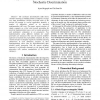Free Online Productivity Tools
i2Speak
i2Symbol
i2OCR
iTex2Img
iWeb2Print
iWeb2Shot
i2Type
iPdf2Split
iPdf2Merge
i2Bopomofo
i2Arabic
i2Style
i2Image
i2PDF
iLatex2Rtf
Sci2ools
DMIN
2006
2006
Hyper-Rectangular and k-Nearest-Neighbor Models in Stochastic Discrimination
The stochastic discrimination (SD) theory considers learning as building models of uniform coverage over data distributions. Despite successful trials of the derived SD method in several application domains, a number of difficulties related to its practical implementation still exist. This paper reports analysis of simple examples as a first step towards presenting the practical implementation issues, such as model generation and preliminary estimations to set parameters. Two implementations using different methods for model generation are discussed. One uses the nearest neighbor approach to maintain the projectability condition, the other constructs hyper-rectangular regions by randomly selecting subintervals in each dimension. Analysis of these implementations shows that for high-dimensional data, parallel model generation with the nearest neighbor approach is a favorable alternative to the interval model generation with random manipulation of the feature subspaces.
| Added | 30 Oct 2010 |
| Updated | 30 Oct 2010 |
| Type | Conference |
| Year | 2006 |
| Where | DMIN |
| Authors | Iryna Skrypnyk, Tin Kam Ho |
Comments (0)

